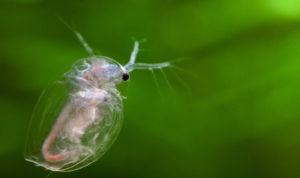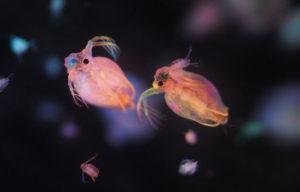Water flea: what daphnia looks like and how to grow it
Daphnia is a crustacean that is food for aquarium fish. They need timely care and proper nutrition. Daphnia is currently on sale. Previously, many people caught them in a natural reservoir. Also crustaceans are called water fleas.
Content
What Daphnia looks like: photo
Description of the insect
Name: Daphnia
Latin: daphniaClass: Insects - Insecta
Squad: Gill-footed crustaceans - Anomopoda
 | Habitats: | stagnant reservoirs |
 | Catering: | algae, plankton elements |
 | Destruction: | insects become victims of different fish |
The small crustacean belongs to the planktonic crustacean variety. The size depends on the type. It can vary from 2 to 6 mm. Due to the tiny size of the body, it is difficult to see the structure. A microscope will help with this.
The body is oval in shape. On both sides there is a special frame. It represents the protection of internal organs. The organs of smell are the antennae on the head. With their help, fleas are able to push off, swim, jump.
There are legs on the chest. Algae and bacteria pass through them. Fleas can breathe through gill sacs. Gill sacs have bristles that act as a filter.
There are over 150 varieties of cladocerans. In our latitudes you can see:
- magnu - the largest species;
- pulexa - has an average size;
- mine - small.
There is always plant food in the stomach. It consists of useful trace elements that the inhabitants of the aquarium need.
Areal
The usual habitat is stagnant ponds. They can live both in a pond and in a deep lake. Even cold Antarctica is no exception.
One of the main conditions is the presence of stagnant freshwater with a minimum amount of soil.
Ground water contributes to soil filtration and algae settling in the intestines.
This leads to clogging. By the presence of crustaceans in the water, it becomes clear how clean the lake, pond, river is. Ground water contributes to soil filtration and algae settling in the intestines. This leads to clogging.
Some species live on the bottom, feeding on dead parts of plant food and the remains of invertebrates. Sometimes they can be seen in puddles and pits with water. In bright light, crustaceans hide in depth. These insects are often found in ponds and lakes.
Daphnia diet
The main diet consists of yeast and blue-green bacteria. A large concentration of unicellular can be found in a flowering reservoir, where few fish live. They also feed on ciliates and detritus.
Filtration of water occurs due to the pectoral legs. After this, food enters the gutter of the abdominal cavity, and then into the esophagus. The salivary glands and the secretion of the upper lips contribute to the gluing of food particles into a lump.
The filtration rate of adults is from 1 to 10 ml during the day. Body weight affects the amount of food. An adult magna is capable of eating 600% of its body weight.
Life cycle
The ability to reproduce does not require fertilization. The females have a brood chamber. It is protected by the edge of the shell. Favorable conditions favor the laying of 50 to 100 unfertilized eggs. In the cavities, the development of females occurs. Next, the females exit the cavity.
In females, molting begins. A few days later, the process of reproduction is repeated with the help of grown-up individuals. One female can have up to 25 offspring during her lifetime. Because of this, the color of the reservoir becomes reddish.
In autumn, males begin to participate in the process. The fertilized shell is very dense. It is able to withstand severe frosts and drying up of water bodies.
With the onset of spring, reproduction is repeated thanks to females. New populations have a different body shape. The life span of large daphnia is 4 to 5 months. Other representatives can reach 3 weeks.
Natural enemies
Enemies are those that eat small animals. Natural enemies include:
- small fish;
- fry;
- snails;
- frogs;
- newt larvae;
- other predatory inhabitants.
Breeding conditions
You can breed daphnia at home. A few tips:
- water should have a greenish or light brown color;
- other representatives of the reservoir are not allowed to enter. For example, the Cyclopes;
- the main diet should be dry lettuce or grapes;
- feed with baker's yeast, which is pre-crushed and filtered through gauze;
- it is enough to draw water from a reservoir in which there are 50 individuals. Cooked food is added to this water;
- use a glass container, but place it away from sunlight;
- adhere to temperatures from 20 to 24 degrees Celsius;
- clean and change the water to avoid the accumulation of litter or silt at the bottom;
- use water that does not contain chlorine and chemical impurities.
Benefits of Daphnia
Daphnia has a high protein content. Amino acids promote rapid growth and development. Most often they are added to dry fish food. In this case, half of the mass is proteins.
Conclusion
Daphnia is a valuable food for aquarium fish, which is sold in stores. Thanks to live food, morbidity is reduced and adaptation to new conditions is easier. However, if desired, you can breed yourself.
Previous

